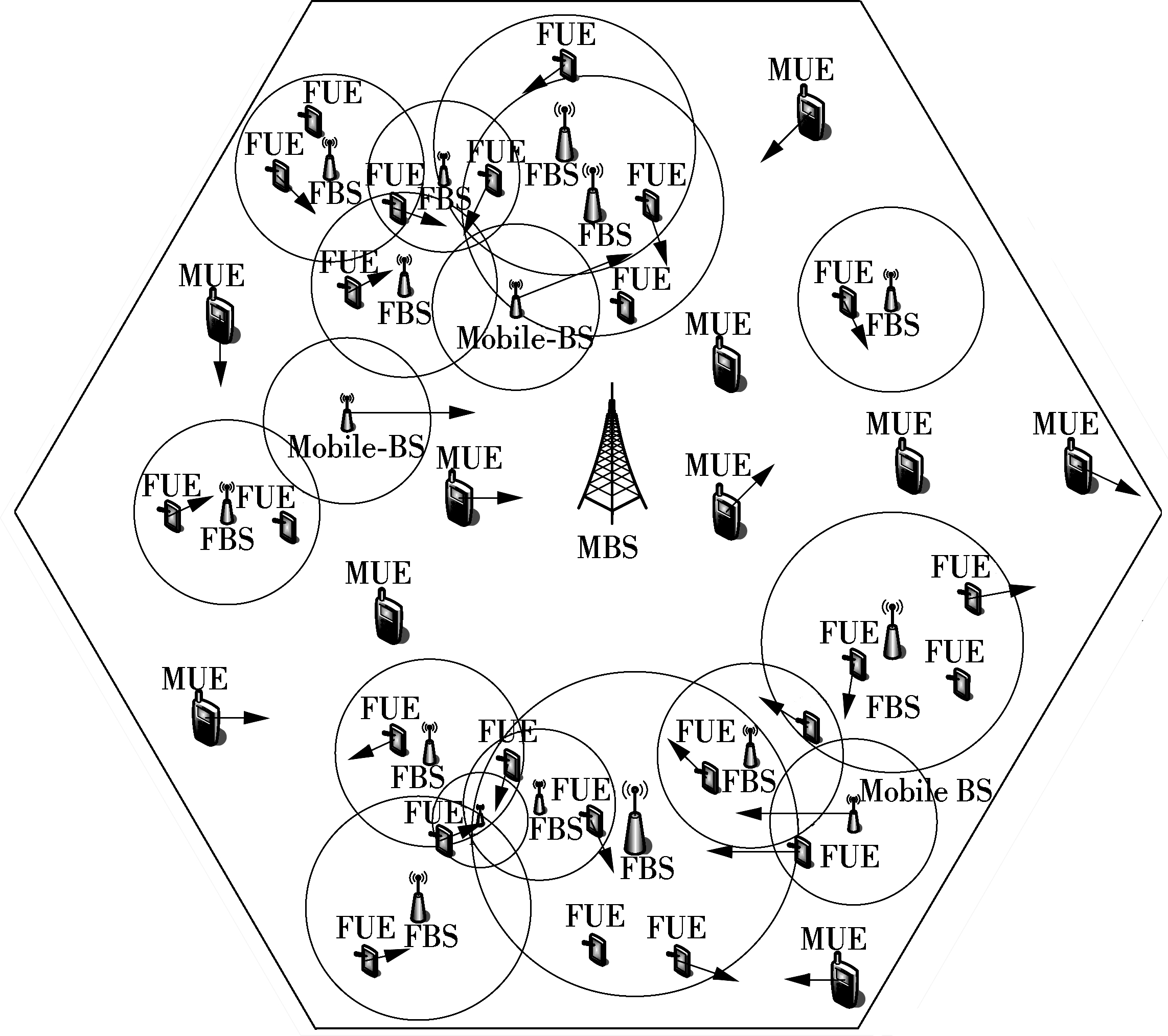
Fig.1 Network model
Abstract:For the dense macro-femto coexistence networks scenario, a long-term-based handover (LTBH) algorithm is proposed. The handover decision algorithm is jointly determined by the angle of handover (AHO) and the time-to-stay (TTS) to reduce the unnecessary handover numbers. First, the proposed AHO parameter is used to decrease the computation complexity in multiple candidate base stations (CBSs) scenario. Then, two types of TTS parameters are given for the fixed base stations and mobile base stations to make handover decisions among multiple CBSs. The simulation results show that the proposed LTBH algorithm can not only maintain the required transmission rate of users, but also effectively reduce the unnecessary numbers of handover in the dense macro-femto networks with the coexisting mobile BSs.
Key words:handover decision algorithm; angle of handover; time-to-stay; dense macro-femto coexistence networks; mobile base station
Using small cell deployments is expected to be a key feature of 4G networks and beyond for a higher transmission rate and better cell-edge coverage. The femtocells with low power and short range characteristics can be deployed to connect the mobile devices to the cellular network[1]. Since the deployments of the femtocells are decided by their owners respectively, the randomness of multiple femtocells locations and their coverage ranges will be presented in the communication networks. And then, a complex handover scene where multiple cells may overlap in the same handover area will appear. Therefore, how to decide an appropriate serving base station (SBS) for each handover user among multiple overlapped cells becomes a major problem.
Some previous research on handover algorithms modeled it as a multiple attribute decision making (MADM) problem according to different metrics[2-3], and others were interested in enhancing throughput[4], dropping outage probability[5], reducing power transmission[6] and so on. However, they mainly concentrated on the quality of service (QoS) without considering the handover algorithm overhead due to the frequency handovers. In Ref.[7], the authors proposed a coordination-based and context-aware mobility management procedure for small cell dense networks using tools from reinforcement learning. An interference-aware handover decision algorithm was proposed in Ref.[8] for the dense yet unplanned network layout, which utilizes standard signal measurements to select the candidate cell. The problem of handover in a high-density small cell deployment was studied in Ref.[9], and a novel local anchor-based architecture for small cells was proposed. However, most research articles mainly focused on the fixed base stations (fixed BSs) such as macrocell and femtocell networks without considering the mobile base stations (mobile BSs) such as WLAN hotspots of the mobile equipment, car-WIFI, and so on.
In this paper, a long-term-based handover (LTBH) algorithm, which jointly considers the angle of handover (AHO) and time-to-stay (TTS) parameters, is proposed for the dense macro-femto networks with the coexisting mobile BSs to reduce the unnecessary handover numbers. Extensive simulations are conducted to show the performance of the proposed algorithm.
A network scenario with a macro-femto two-tier overlay structure is considered in this paper, as shown in Fig.1. In this scenario, multiple femtocell base stations (FBSs) are deployed fixedly around the center macrocell base station (MBS) and some mobile BSs, which are derived from the mobile devices with a WLAN hotspot option, move within the macrocell network. Meanwhile, the macrocell users (MUEs), the femtocell users (FUEs), and the mobile BSs can reach any region at will due to mobility. Furthermore, the mobile BSs can play a role in serving its nearby users if necessary.
Let pi,∀i∈{0,1,…,F+M} denote the allocated power of BS i for the user in the downlink transmission.

Fig.1 Network model
Specifically, p0,{![]() and {
and {![]() represent the allocated power of the MBS, FBSs and mobile BSs, respectively. The allocated power can be obtained by using the resource allocation schemes in multiple existing articles. Therefore, the transmission rate of mobile user k in BS i can be given by
represent the allocated power of the MBS, FBSs and mobile BSs, respectively. The allocated power can be obtained by using the resource allocation schemes in multiple existing articles. Therefore, the transmission rate of mobile user k in BS i can be given by

(1)
where λk is the utility gain per unit transmission-rate for user k; Hk,i denotes the channel power gain between the BS i and the mobile user k. Furthermore, the split spectrum scheme[10] is utilized between the FBSs and mobile BSs. Thus, there are no co-channel interferences between the FBSs and mobile BSs or the co-tier interferences arising among femtocells in this paper.
In this section, we present the LTBH algorithm for dense macro-femto networks with the coexisting mobile BSs.
2.1 Handover trigger parameter
Due to the mobility of the users, the channel conditions are varying continuously and the obtained transmission rate of each user from its SBS will also fluctuate. To mitigate the ping-pong effect caused by the interference uncertainty and the channel fluctuation, a pair of QoS thresholds, i.e. ![]() and
and ![]() , is used. For example, user k will launch the handover procedure if and only if the obtained QoS from its SBS
, is used. For example, user k will launch the handover procedure if and only if the obtained QoS from its SBS ![]() is lower than the lower bound of the threshold
is lower than the lower bound of the threshold ![]() .The upper bound of the threshold
.The upper bound of the threshold ![]() is used to initialize the candidate base stations’(CBSs) selection at the handover beginning.
is used to initialize the candidate base stations’(CBSs) selection at the handover beginning.
2.2 AHO and TTS parameters
After launching the handover procedure, each mobile user waiting for handover should select one of its multiple CBSs as its next SBS. Therefore, in this section we will introduce two parameters, AHO and TTS, to make the handover decision in the dense macro-femto networks with the coexisting mobile BSs scenario. First, AHO is proposed to reduce the set of the CBSs. Then, the TTS parameters for the fixed BSs and mobile BSs are given to determine which one among multiple CBSs should be selected to be the SBS.
2.2.1 AHO parameter
Due to the different types of the BSs (fixed BS and mobile BS), two different algorithms will be designed to calculate the AHO parameters.
1) The movement tendency vector of the mobile user
In this research, it can be assumed that the user can locate his/her position accurately with the help of the GPS receiver and send this information to the BS via the uplink channel. The average direction angle ![]() (t), which indicates the tendency of user movement angle, can be calculated based on the location information[11-12].
(t), which indicates the tendency of user movement angle, can be calculated based on the location information[11-12].
After giving ![]() (t), the movement tendency vector of the user k denoted as λk(t) can be calculated by
(t), the movement tendency vector of the user k denoted as λk(t) can be calculated by
λk(t)=[‖vk‖![]() ‖vk‖
‖vk‖![]()
(2)
where ‖vk‖ denotes the 2-norm of the velocity for the mobile user k.
Then, the AHO parameters for the fixed BSs and the mobile BSs shown in Fig.2 will be given as follows.
2) AHO between the mobile user and the fixed BS
Fig.2(a) shows the AHO between the mobile user k and its fixed CBSs. The position of user k at time t and the fixed BS i are denoted as (xk(t), yk(t)) and (xi,yi), respectively. Then, the vector between the user k and the fixed BS i at time t can be calculated as
(3)
Thus, the AHO between the mobile user k and the fixed BS i at time t, which can be calculated by
∀i∈F,∀k∈K
(4)
3) AHO between the mobile user and the mobile BS
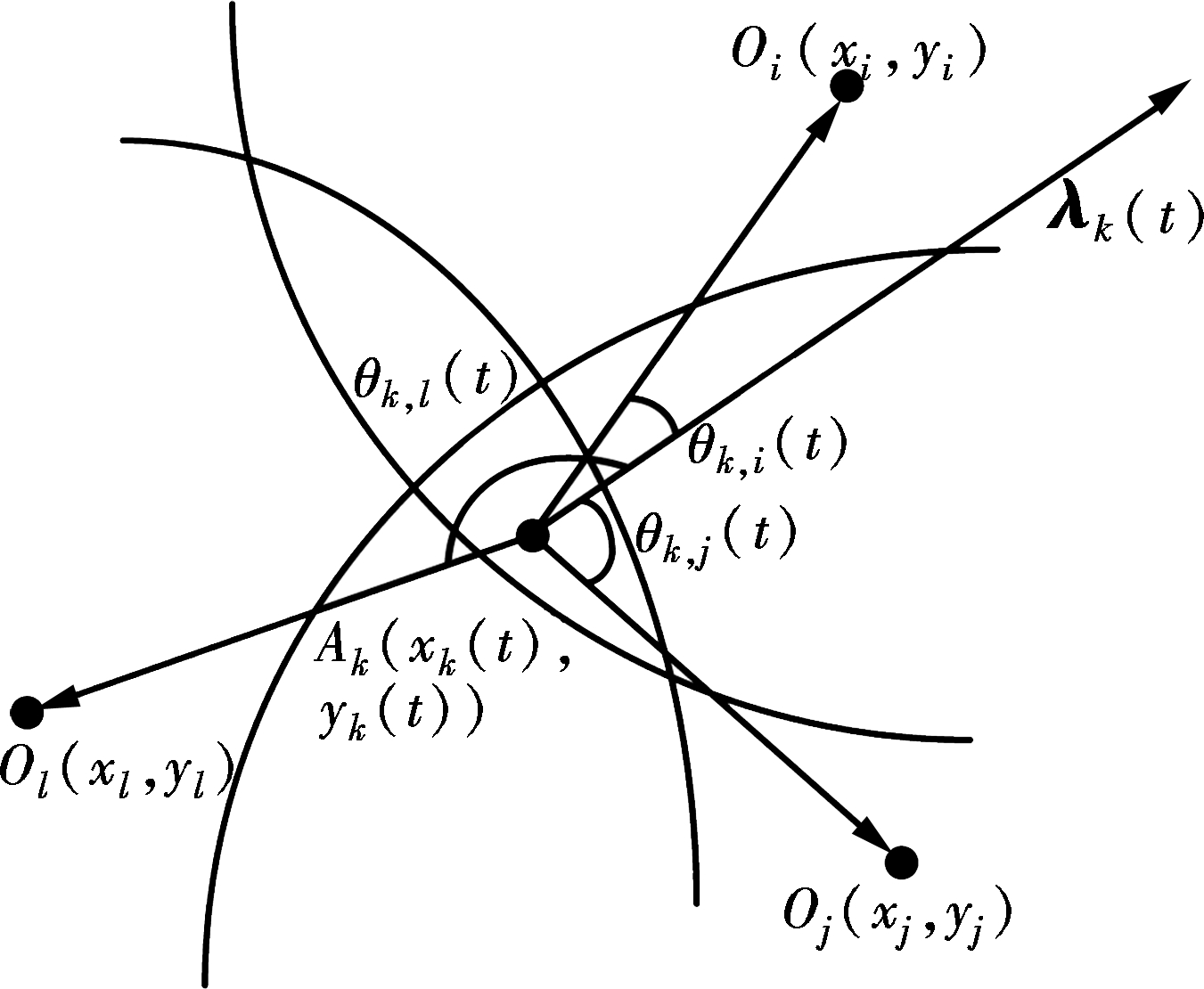
(a)
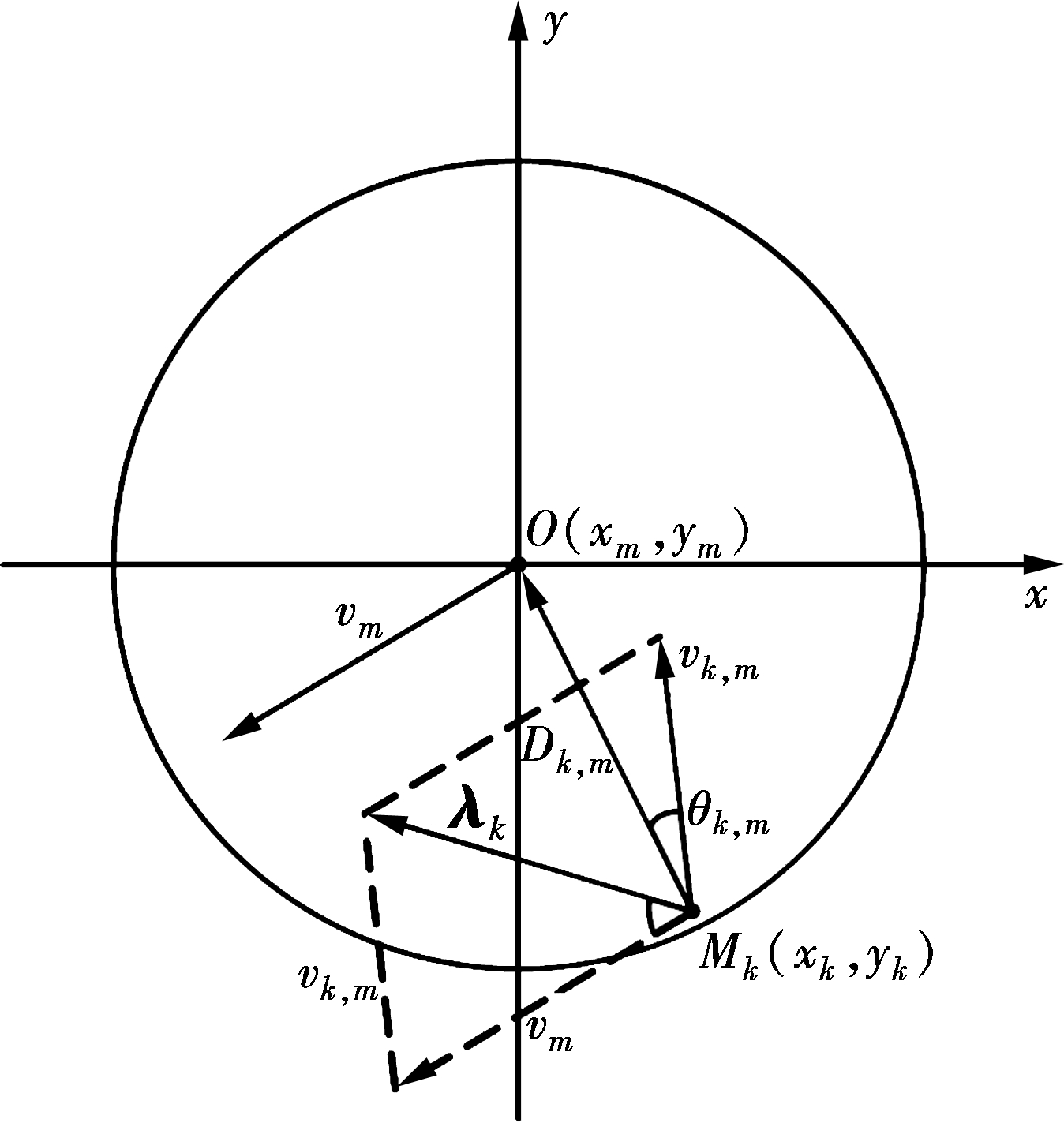
(b)
Fig.2 Illustration of the AHO for the fixed BSs and mobile BSs. (a) The AHO between the mobile user and the fixed BSs; (b) The AHO between the mobile user and the mobile BSs
The AHO between the mobile user k and the mobile BS m is illustrated in Fig.2(b). Due to the fact that the mobile BSs are derived from the mobile devices with WLAN hotspot option, they will travel at a certain speed and have overlay areas to support nearby users’ services. Therefore, the mobile users may be handed over to these WLAN hotspots also for better performance. It is worth nothing that the mobile BS m also has a velocity vector vm(t) when moving. Thus, the AHO between the mobile user k and the mobile BS m at time t can be expressed as
∀m∈M, ∀k∈K
(5)
where λk(t)-vm(t) denotes the relative velocity of mobile user k in the relative static mobile BS m.
4) CBSs set reduction for the dense macro-femto handover scheme
Multiple CBSs may appear in the same handover area, resulting in greater handover decision computation complexity. Therefore, how to reduce the CBSs becomes a major problem.
According to the definition of the AHO, θk,i(t) represents the intersection angle at which mobile user k travels towards BS i.Thus, the larger the AHO, the farther away the mobile user k travels towards BS i. Let ![]() denote the AHO threshold for mobile user k. When θk,i(t) is larger than
denote the AHO threshold for mobile user k. When θk,i(t) is larger than ![]() , BS i will be removed from the handover CBSs of mobile user k; otherwise, BS i will be retained in the CBSs. Therefore, a reasonable
, BS i will be removed from the handover CBSs of mobile user k; otherwise, BS i will be retained in the CBSs. Therefore, a reasonable ![]() should be decided to reduce the number of the CBSs.Based on the definition of the AHO threshold, the reasonable
should be decided to reduce the number of the CBSs.Based on the definition of the AHO threshold, the reasonable ![]() should be decided according to the movement track of user k. For example, for the curvilinear motion users, the thresholds should be set much larger than those for rectilinear motion users.
should be decided according to the movement track of user k. For example, for the curvilinear motion users, the thresholds should be set much larger than those for rectilinear motion users.
However, due to the random deployment and coverage areas of the FBSs or mobile BSs, only considering the AHO parameter for the handover decision may result in some unnecessary handovers. Therefore, in the next two sections, the TTS parameter is proposed to assist the handover decision in the dense macro-femto networks. Since two different types of BSs (fixed BS and mobile BS) are considered in this paper, two distinguishing computing methods for calculating these two TTS parameters will be proposed in section 2.2.2 and 2.2.3, respectively.
2.2.2 TTS in the fixed BS
In this section, the calculation of the TTS in the fixed BSs is given. As shown in Fig.3, there are ![]() fixed BSs for user k, where the SBS is serving the mobile user k with poor QoS, i.e.
fixed BSs for user k, where the SBS is serving the mobile user k with poor QoS, i.e. ![]() ,and one among these
,and one among these ![]() fixed BSs will be chosen as its next SBS.
fixed BSs will be chosen as its next SBS.
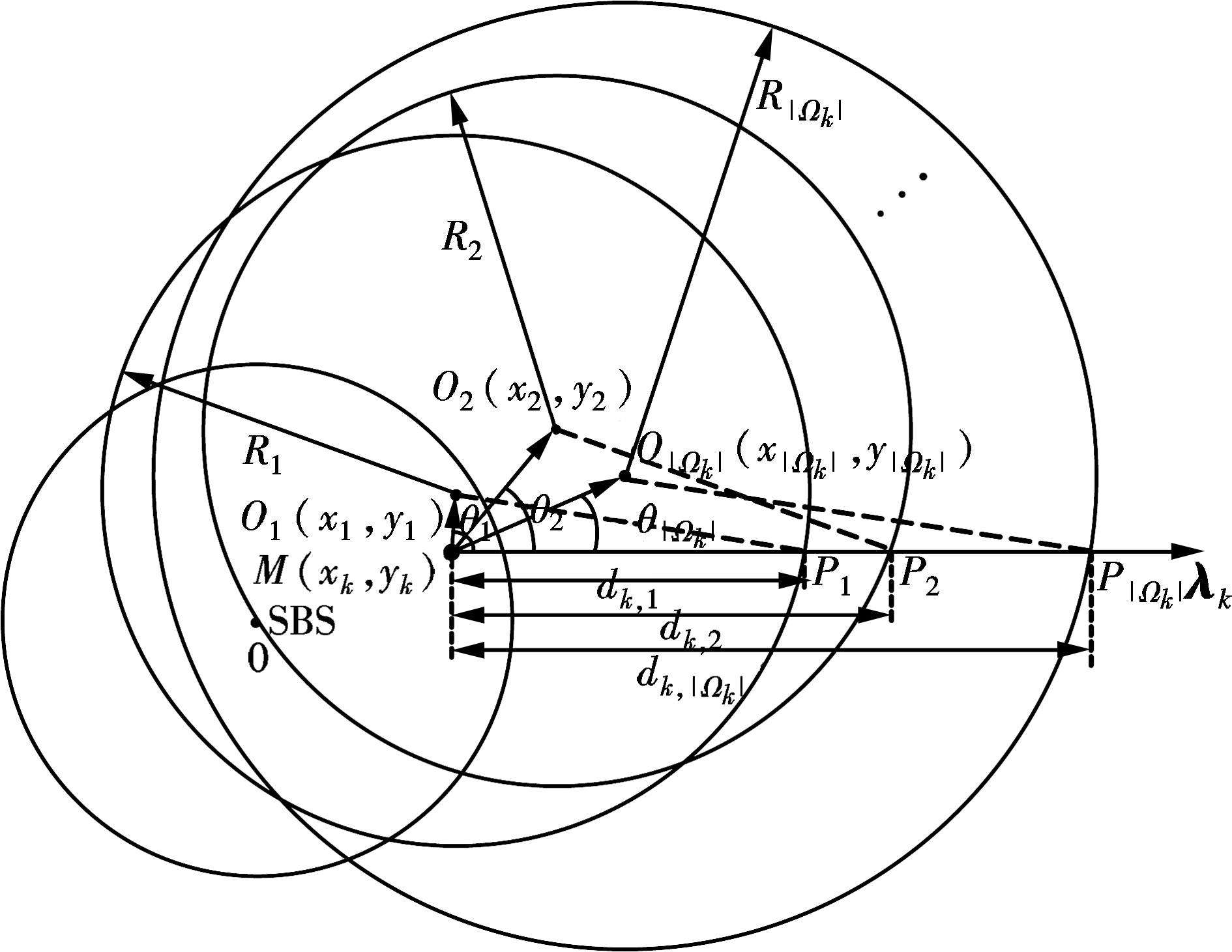
Fig.3 Illustration of the TTS in the fixed BSs
As we can see in Fig.3, the circle of the CBS j,∀j∈{![]() },meets the movement tendency vector of user k,i.e., λk, at the point Pj. The triangle △OjMPj will be used to calculate the distance that user k travels in the CBS j. By using the cosine law and some simple operations, the distance dk,j is given as
},meets the movement tendency vector of user k,i.e., λk, at the point Pj. The triangle △OjMPj will be used to calculate the distance that user k travels in the CBS j. By using the cosine law and some simple operations, the distance dk,j is given as
(6)
![]() j.
j.
Due to the fact that the mobile user locates inside all its CBSs inside, clearly ![]() ≥0 is always satisfied. Then, we can obtain
≥0 is always satisfied. Then, we can obtain ![]() ≥Dk,jcosθk,j.Since dkj represents the distance, it may be equal or greater than zero. Therefore, the distance that user k travels in the CBS j can be given as
≥Dk,jcosθk,j.Since dkj represents the distance, it may be equal or greater than zero. Therefore, the distance that user k travels in the CBS j can be given as
(7)
Therefore, the TTS for user k in the fixed BS j can be given by
∀k∈K, ∀j=F
(8)
2.2.3 TTS in the mobile BS
In this section, the TTS for the mobile BSs, i.e., TTSM, will be given. As the assumption in this paper, the mobile BSs also have their movements in the macrocell network, resulting in different methods for TTS calculation. Fig.4 shows the illustration of the TTS in the mobile BSs.
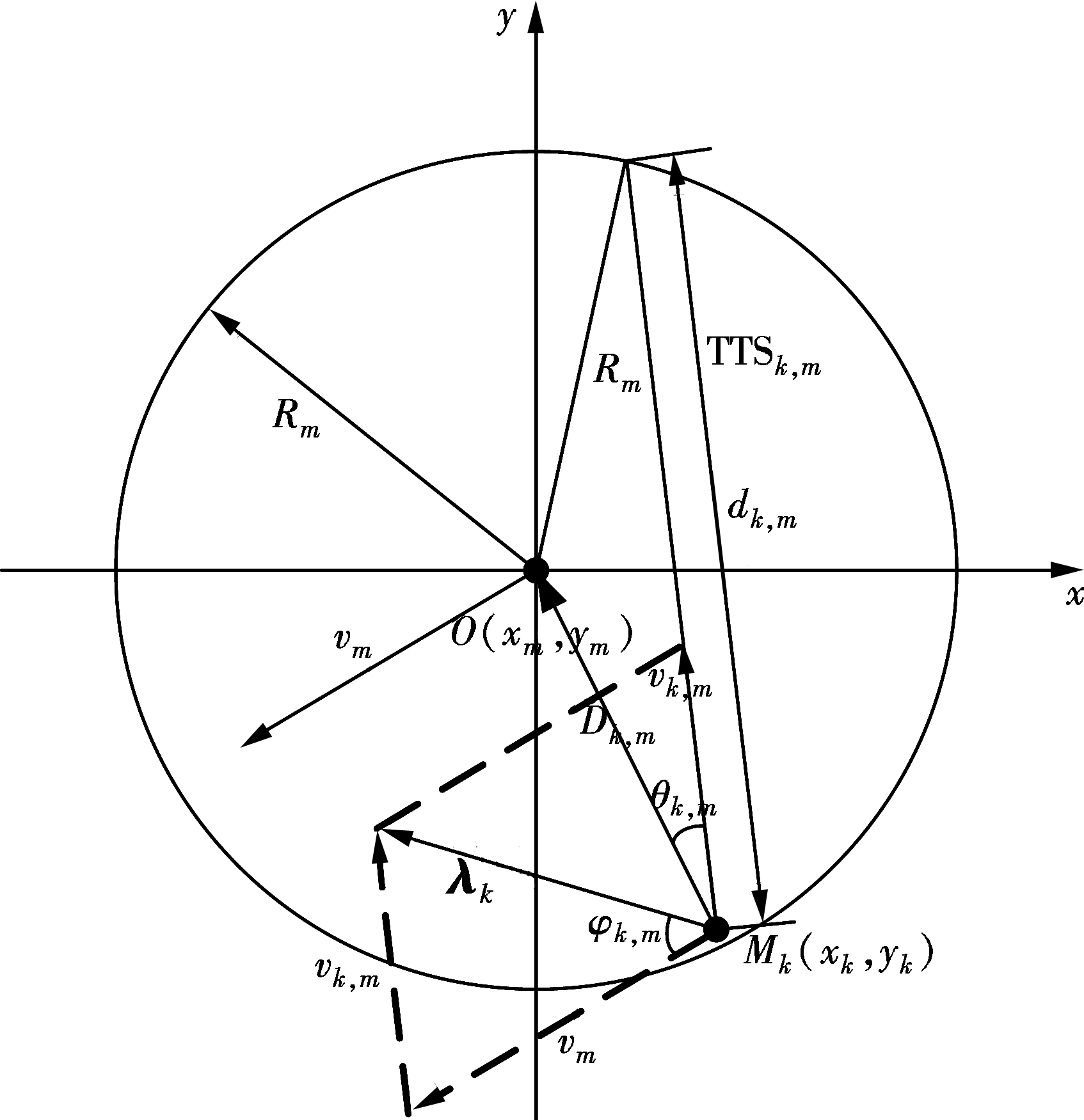
Fig.4 Illustration of the TTS in the mobile BSs
Due to different velocity vectors of mobile user k and mobile BS m, the well known relative motion theory should be used to calculate the TTS in the mobile BS. Thus, the relative velocity vector vk,m(t) , which is the velocity vector of mobile user k relative to static mobile BS m, can be given by
vk,m(t)=vk(t)-vm(t)
(9)
Also, the relative velocity of user k relative to the mobile BS m can be calculated as
(10)
![]() .
.
It can be seen that for a given pair of vk and vm, the relative velocity increases with φk,m∈[0,π].Therefore, if φk,m=π, the maximal relative velocity will be obtained, in which vk,m=vk+vm. On the other hand, if φk,m=0, the minimal relative velocity ![]() will be obtained. Furthermore, if vk=vm and φk,m=0, mobile user k will be at relative rest in the mobile BS m reference frame. Then, mobile user k may have the maximal TTS in the mobile BS m than in other BSs.
will be obtained. Furthermore, if vk=vm and φk,m=0, mobile user k will be at relative rest in the mobile BS m reference frame. Then, mobile user k may have the maximal TTS in the mobile BS m than in other BSs.
The relative motion distance of mobile user k in the mobile BS m reference frame can be given as
(11)
After obtaining vk,m and dk,m, the TTS for user k in the mobile BS m, i.e.![]()
(12)
By using the TTS parameter, the CBSs with the maximal TTS is chosen as the next SBS of mobile user k.
In this section, the LTBH algorithm procedure is presented.
1) For mobile user k, if the QoS of its SBS, i.e., ![]() , is larger than its QoS lower bound
, is larger than its QoS lower bound ![]() , mobile user k will still be served by its current SBS. Otherwise, it will launch the handover procedure and the algorithm will go to 2).
, mobile user k will still be served by its current SBS. Otherwise, it will launch the handover procedure and the algorithm will go to 2).
2) If ![]() and there is any CBSs, which can provide
and there is any CBSs, which can provide ![]() , the algorithm will continue in 3). However, if there is no CBSs which can provide
, the algorithm will continue in 3). However, if there is no CBSs which can provide ![]() , mobile user k will access the MBS for basic service.
, mobile user k will access the MBS for basic service.
3) Then, calculate the AHO of all the CBSs, i.e., {![]() , and compare them with the AHO threshold of mobile user k to give the CBSs for the TTS calculation in 4).
, and compare them with the AHO threshold of mobile user k to give the CBSs for the TTS calculation in 4).
4) After determining the CBSs for the TTS calculation, the TTSF and TTSM for the fixed BSs and mobile BSs will be obtained by Eqs.(8) and (12), respectively. Finally, the BS, which has the maximal TTS among {TTSF,TTSM}, is selected as the handover target BS.
In this section, numerical simulations are conducted to evaluate the performance of the proposed LTBH algorithm in terms of the handover number and the transmission rate in the dense macro-femto networks with the coexisting mobile BSs.
4.1 Simulation setup
The proposed LTBH algorithm will be compared with the traditional transmission rate maximization handover (TH) algorithm. To reflect the mobility and randomness of the networks, the initial locations and movement directions of the mobile users and BSs are random, and the mobile equipment, i.e., mobile users and mobile BSs, move based on their former directions. Each simulation lasts for 500 s and the simulations are repeated 100 times to obtain stable statistical performance results. Some simulation parameters are given in Tab.1.
Path losses of different links are adopted from Ref.[13], in which D denotes the distance between the transmitter and receiver, Lw is the wall penetration loss that is set to be 0.8 and dindooris the nearest available distance from the FBS to the user which is set to be 0.5 m.
Tab.1 Simulation parameters
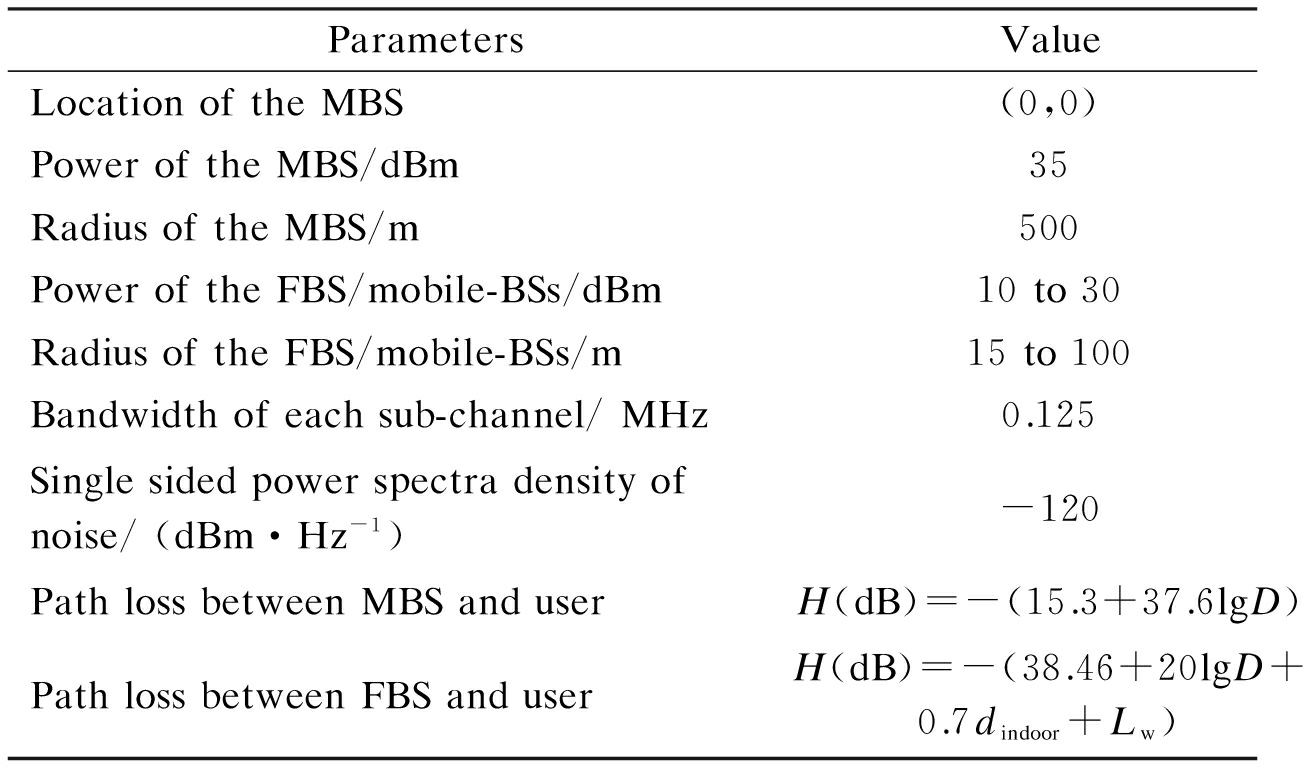
ParametersValueLocationoftheMBS(0,0)PoweroftheMBS/dBm35RadiusoftheMBS/m500PoweroftheFBS/mobile-BSs/dBm10to30RadiusoftheFBS/mobile-BSs/m15to100Bandwidthofeachsub-channel/MHz0.125Singlesidedpowerspectradensityofnoise/(dBm·Hz-1)-120PathlossbetweenMBSanduserH(dB)=-(15.3+37.6lgD)PathlossbetweenFBSanduserH(dB)=-(38.46+20lgD+0.7dindoor+Lw)
4.2 Simulation results
The performance of the proposed LTBH algorithm against the numbers of the FBSs is depicted in Fig.5. It can be seen that the number of handover shown in Fig.5(a) and the average transmission rate of each user shown in Fig.5(c) in the proposed LTBH algorithm will be less than that in the TH algorithm with a different number of the FBSs. It can be concluded that using the TTS parameter in the proposed LTBH algorithm can obtain better performance in reducing handover numbers at the cost of poor QoS.
To further show the performance, the percentages of the handover number difference and the transmission rate difference between these two algorithms are given in Figs.5(b) and (d), respectively, by calculating ![]() ×100%, where NTH and NLTBH denote the handover number or the transmission rate in the TH and LTBH algorithms, respectively. It can be seen that with the numbers of FBSs increasing, the proposed LTBH alg-orithm can reduce more unnecessary handover numbers than the sacrificial transmission rate. Therefore, the proposed algorithm can be effectively used in the dense macro-femto networks to reduce the handover numbers.
×100%, where NTH and NLTBH denote the handover number or the transmission rate in the TH and LTBH algorithms, respectively. It can be seen that with the numbers of FBSs increasing, the proposed LTBH alg-orithm can reduce more unnecessary handover numbers than the sacrificial transmission rate. Therefore, the proposed algorithm can be effectively used in the dense macro-femto networks to reduce the handover numbers.
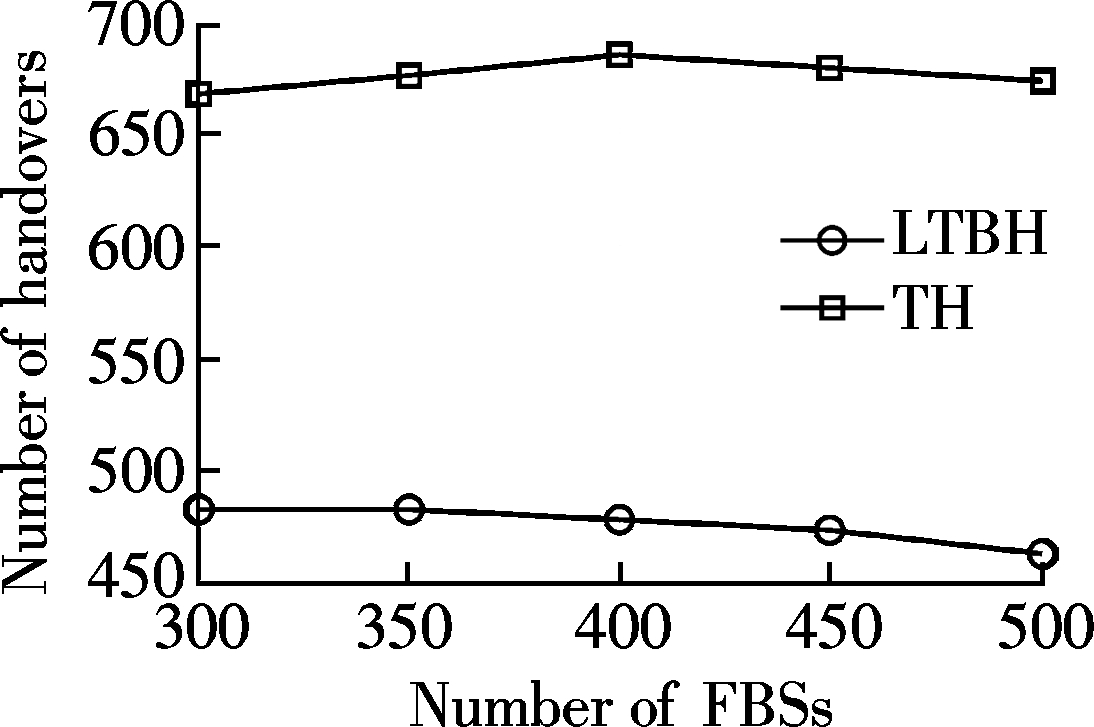
(a)

(b)

(c)
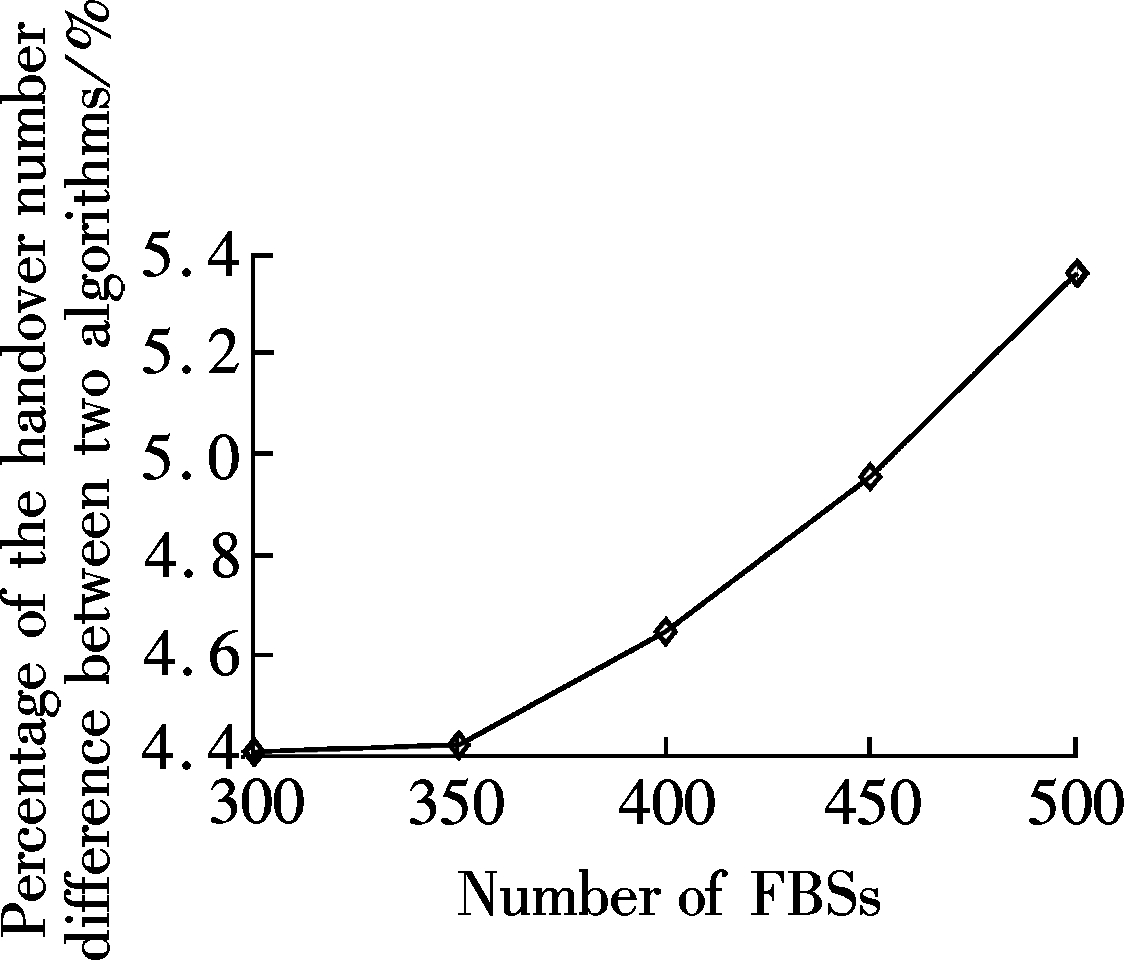
(d)
Fig.5 Numbers of handover and average transmission rate vs. numbers of the FBSs. (a) Number of handovers; (b) Percentage of the handover number difference between two algorithms; (c) Average transmission rate; (d) Percentage of the average transmission rate difference between two algorithms via number of the FBSs
Then, the performance of the LTBH algorithm against the number of mobile BSs is given in Fig.6. It can be seen that the number of handovers in the LTBH decreases with the increase of the number of mobile BSs, so does the average transmission rate of each user. The reason is that the more mobile BSs that randomly appear in the network, the greater the possibility that the handover users travel in the same direction with some mobile BSs at their edge. It also can be seen that, in the proposed LTBH algorithm, ![]() can be set higher to provide a faster transmission rate, but more handover numbers will be triggered. It can be concluded that the proposed LTBH algorithm can effectively reduce the unnecessary number of handovers in the mobile BSs networks.
can be set higher to provide a faster transmission rate, but more handover numbers will be triggered. It can be concluded that the proposed LTBH algorithm can effectively reduce the unnecessary number of handovers in the mobile BSs networks.
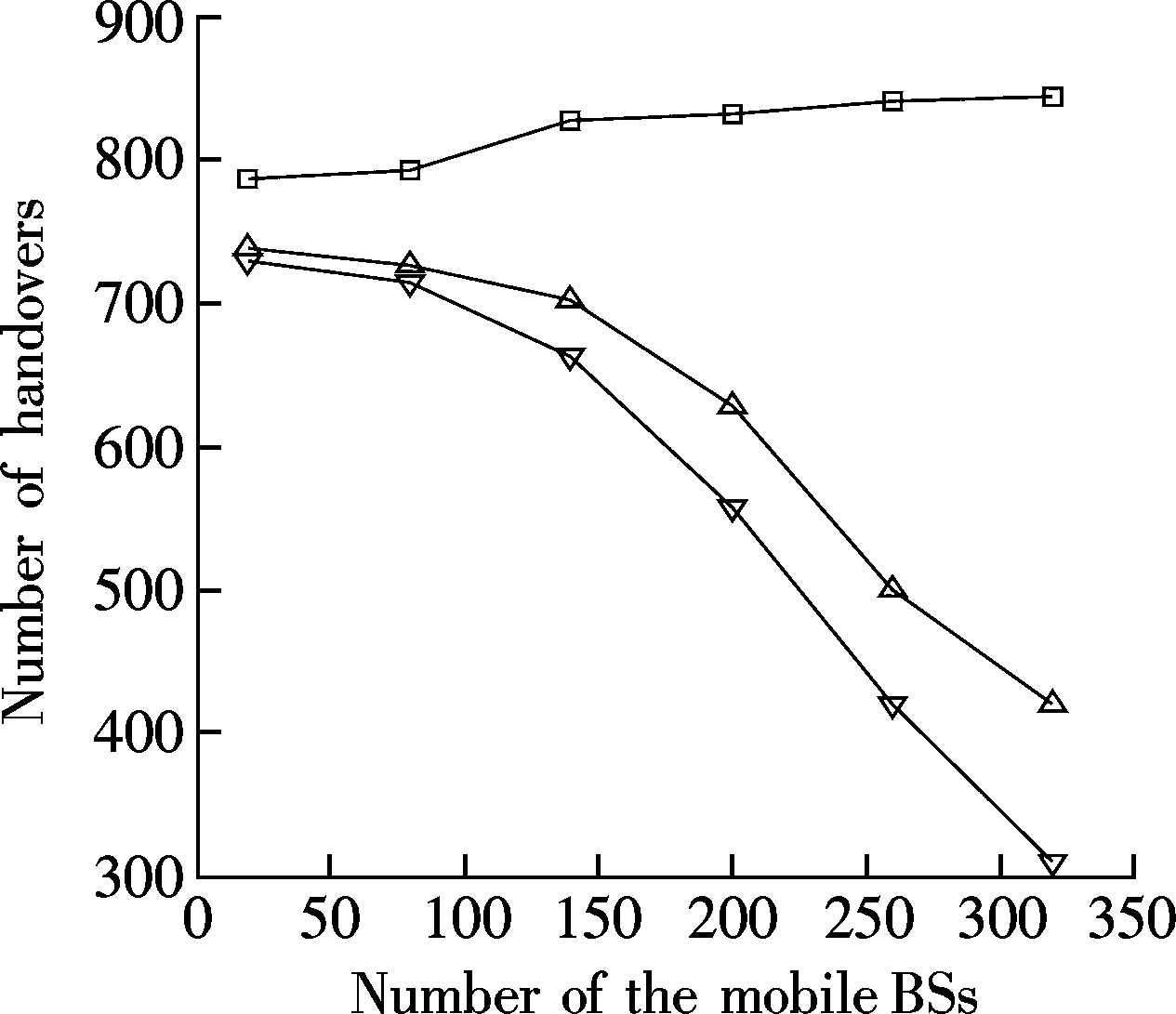
(a)
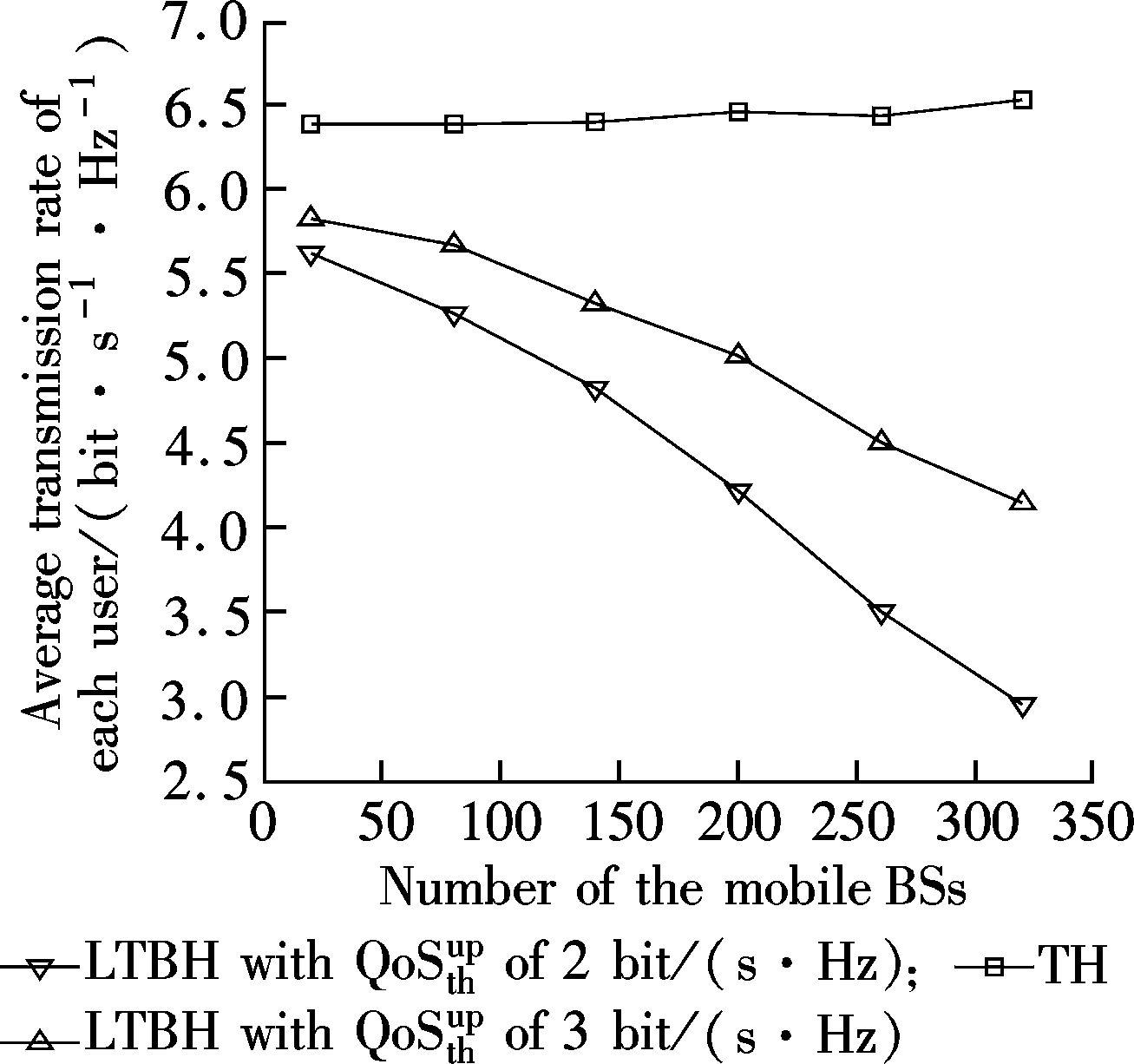
(b)
Fig.6 Number of handovers and average transmission rate vs. number of mobile BSs. (a) Number of handovers; (b) Average transmission rate vs. number of the mobile BSs
Fig.7 shows the performance of the LTBH algorithm in terms of the flops[14] and average transmission rate of each user vs. the AHO threshold, respectively. It can be seen that by using the AHO threshold, the flops of handover calculation will decrease with the AHO threshold, and the average transmission rate of each user decreases with the AHO threshold when the AHO threshold is smaller than 90° . It can be explained that when the AHO threshold is small, there may be fewer or even no CBSs for TTS calculation. Based on the proposed LTBH algorithm, more users will access the MBS. Therefore, a reasonable AHO threshold should be decided to decrease the computation complexity with a proper transmission rate.
The performance in terms of the number of handovers and average transmission rate of each user vs. ![]() are depicted in Figs.8(a) and (b), respectively. It can be seen that the number of handovers increases with
are depicted in Figs.8(a) and (b), respectively. It can be seen that the number of handovers increases with ![]() first, but decrease when
first, but decrease when ![]() is large enough. So does the average transmission rate of each user. The reason is that a higher
is large enough. So does the average transmission rate of each user. The reason is that a higher ![]() will reduce the set of CBSs, resulting in higher than average transmission rate and a greater number of handover. However, when
will reduce the set of CBSs, resulting in higher than average transmission rate and a greater number of handover. However, when ![]() is high enough, there may be no CBSs for handover, and then the users will access the MBS for basic service.
is high enough, there may be no CBSs for handover, and then the users will access the MBS for basic service.
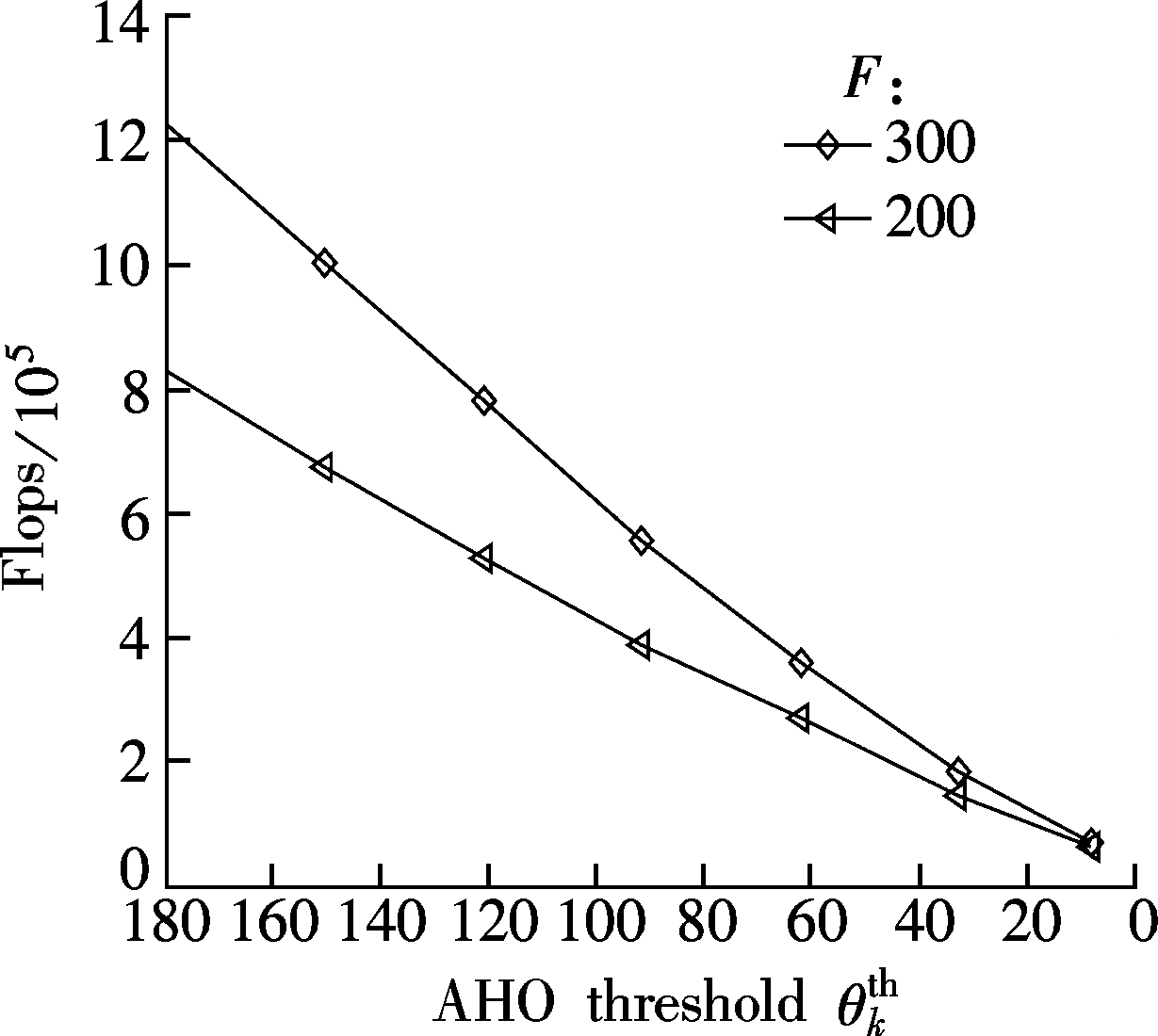
(a)
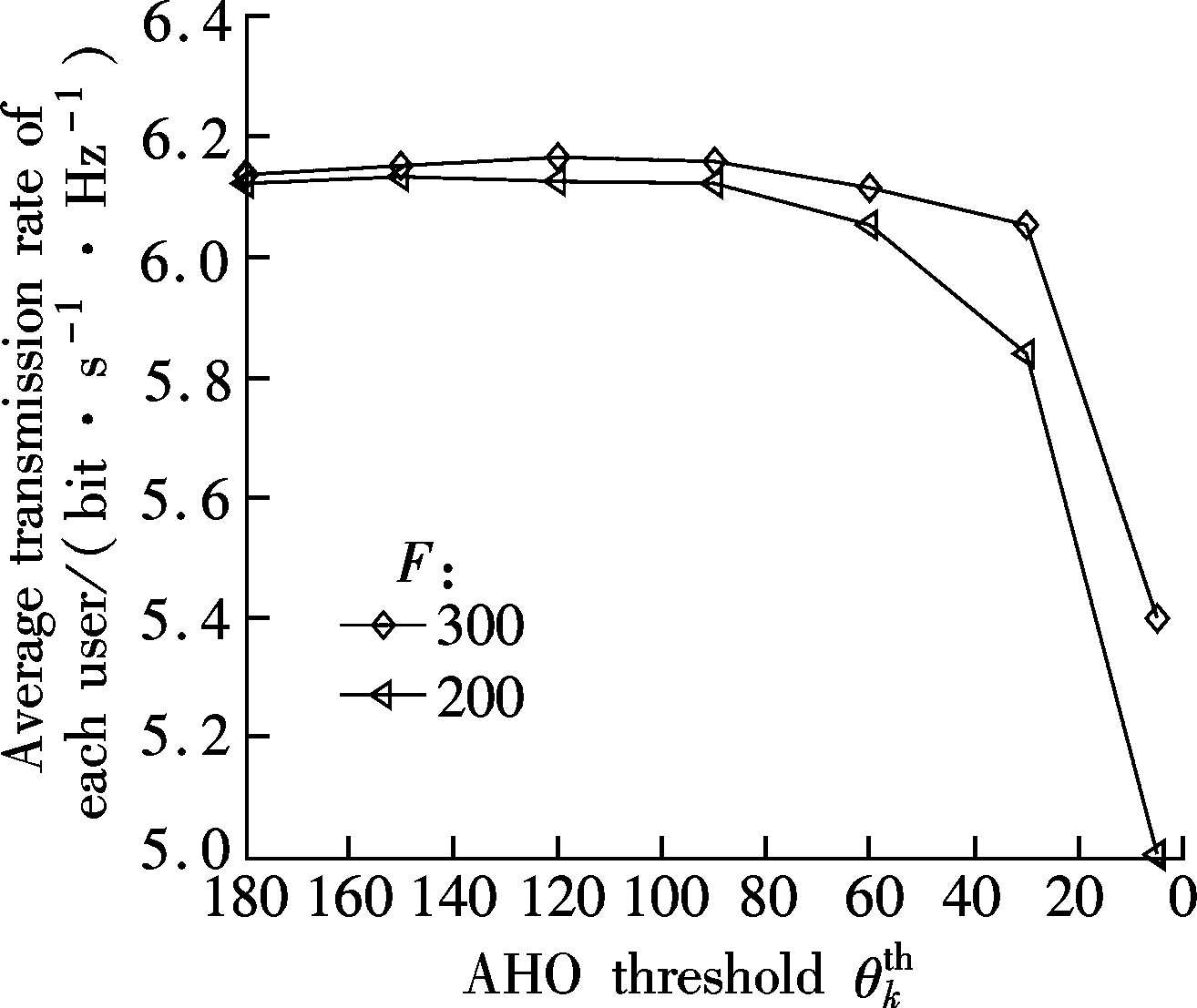
(b)
Fig.7 Flops and average transmission rate vs. AHO threshold. (a) Flops; (b) Average transmission rate vs. AHO threshold
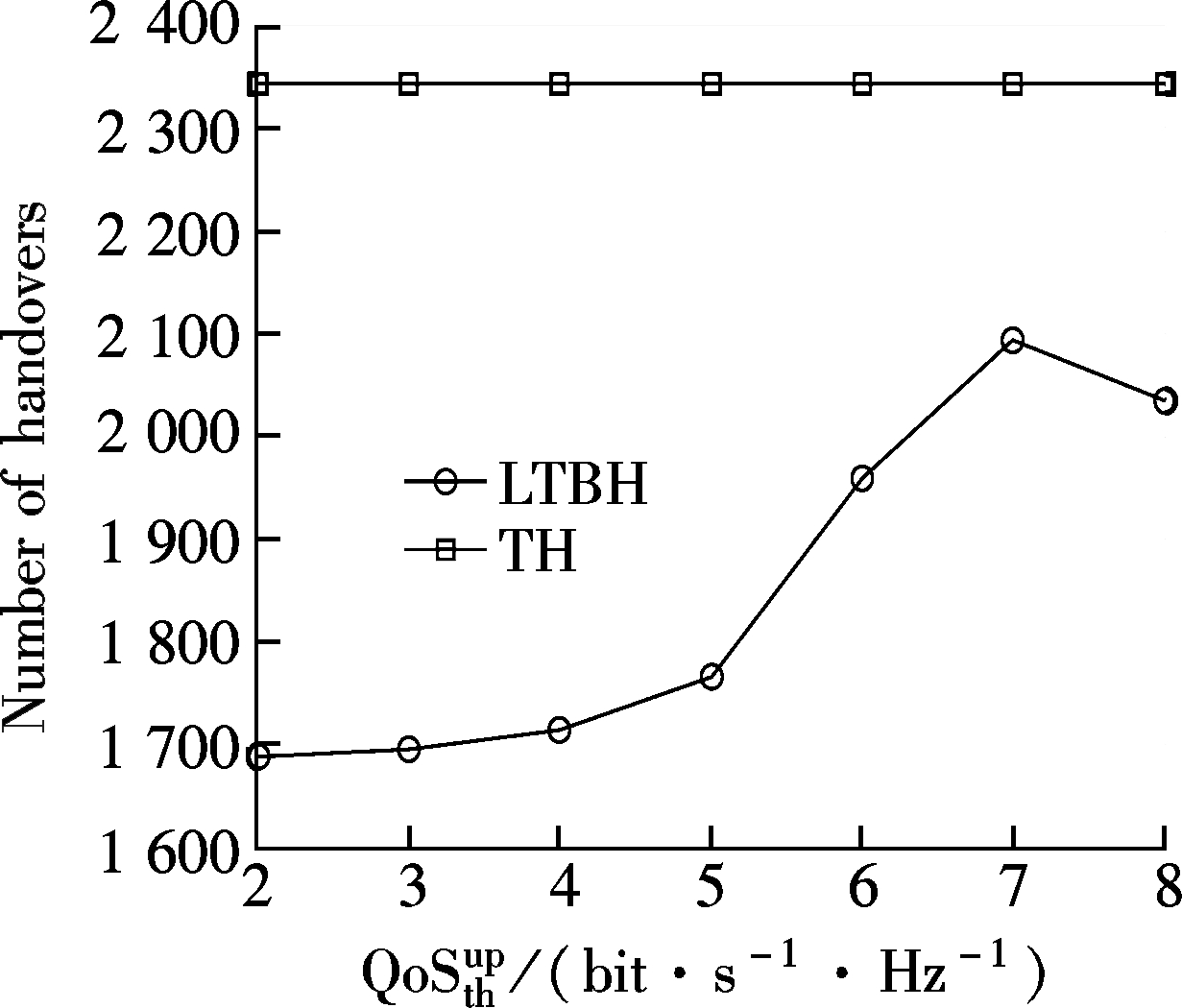
(a)
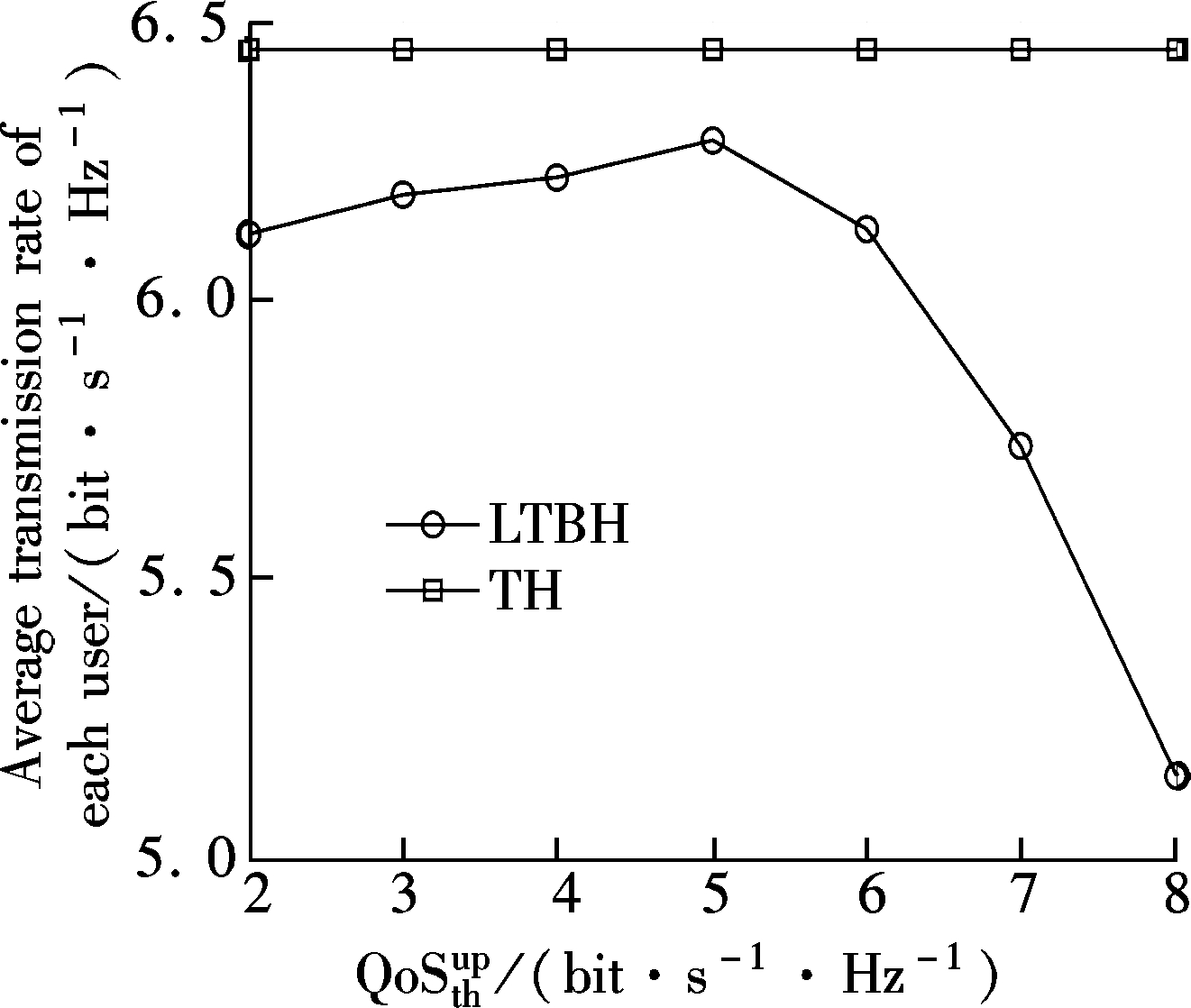
(b)
Fig.8 Number of handovers and average transmission rate vs. ![]() .(a) Number of handovers; (b) Average transmission rate vs.
.(a) Number of handovers; (b) Average transmission rate vs. ![]()
This paper proposes a LTBH algorithm for the dense macro-femto networks with the coexisting mobile BSs. To reduce the computation complexity and unnecessary handover numbers, the proposed LTBH algorithm jointly uses the AHO and TTS parameters to decide which BS should be chosen as the handover target BS among multiple fixed BSs and mobile BSs. The simulation results show that the proposed algorithm can effectively reduce the unnecessary number of handovers in the dense macro-femto networks with a coexisting mobile BSs.
[1]Gambini J, Spagnolini U. Wireless over cable for femtocell systems [J]. IEEE Communications Magazine, 2013, 51(5): 178-185. DOI:10.1109/mcom.2013.6515063.
[2]Li L, Chu X, Zhang J. A hierarchical MADM-based network selection scheme for system performance enhancement [C]//2014 IEEE International Conference on Communication Systems. Macau, China, 2014: 122-126. DOI:10.1109/mcom.2013.6515063.
[3]Mansouri M, Leghris C, Bekkhoucha A. Towards a better combination of the MADM algorithms for the vertical handover optimization in a mobile network multi-access environment [C]//2015 10th International Conference on Intelligent Systems: Theories and Applications. Rabat, Morocco, 2015: 15678139-1-15678139-5. DOI:10.1109/sita.2015.7358421.
[4]Choi H. An optimal handover decision for throughput enhancement [J]. IEEE Communications Letters, 2010, 14(9): 851-853. DOI:10.1109/lcomm.2010.09.092356.
[5]Tamea G, Biagi M, Cusani R. Soft multi-criteria decision algorithm for vertical handover in heterogeneous networks [J]. IEEE Communications Letters, 2011, 15(11): 1215-1217. DOI:10.1109/lcomm.2011.090911.111537.
[6]Xenakis D, Passas N, Verikoukis C. A novel handover decision policy for reducing power transmissions in the two-tier LTE network [C]//2012 IEEE International Conference on Communications. Ottawa, Canada, 2012: 1352-1356. DOI:10.1109/icc.2012.6363941.
[7]Simsek M, Bennis M, Güvenc I. Context-aware mobility management in HetNets: A reinforcement learning approach [C]//2015 IEEE Wireless Communications and Networking Conference. New Orleans, USA, 2015: 1536-1541. DOI:10.1109/wcnc.2015.7127696.
[8]Xenakis D, Passas N, Merakos L, et al. Energy-efficient and interference-aware handover decision for the LTE-advanced femtocell network [C]//2013 IEEE International Conference on Communications. Budapest, Hungary, 2013: 2464-2468. DOI:10.1109/icc.2013.6654902.
[9]Balakrishnan R, Akyildiz I. Local anchor schemes for seamless and low-cost handover in coordinated small cells [J]. IEEE Transactions on Mobile Computing, 2015, 15(5): 1182-1196.
[10]Chen Y, Zhang J, Zhang Q. Utility-aware refunding framework for hybrid access femtocell network [J]. IEEE Transactions on Wireless Communications, 2012, 11(5): 1688-1697. DOI:10.1109/twc.2012.031212.110002.
[11]Chen G, Zheng J, Shen L. A preset threshold based cross-tier handover algorithm for uplink co-channel interference mitigation in two-tierfemtocell networks [C]//2013 IEEE Globecom. Atlanta, USA, 2013: 4717-4722.
[12]Liu C, Xia W, Chen G, et al. Location-aware handover decision algorithm in multi-cell networks [C]//2013 International Conference on Wireless Communications and Signal Processing. Hangzhou, China, 2013: 1-6.
[13]Hashem K, Yousefi S, Shayesteh M. Adaptive handover algorithm in heterogeneous femto cellular networks based on received signal strength and signal-to-interference-plus-noise ratio prediction [J]. IET Communications, 2014, 8(17): 3061-3071. DOI:10.1049/iet-com.2014.0230.
[14]Liu C, Xing S, Shen L. Dynamic hybrid-access control in multi-user and multi-femtocell networks via stackelberg game competition [J]. IET Communications, 2016, 10(7): 862-872. DOI:10.1049/iet-com.2015.0684.
References:
摘要:针对密集macro-femto融合网络,提出一种基于长期稳定的切换(long-term-based handover,LTBH)决策算法.该算法由切换角(angle of handover,AHO)和逗留时间(time-to-stay,TTS)2种参数联合进行切换判决,从而有效减小冗余切换次数.首先,在大量候选基站(candidate base stations,CBSs)场景中提出了AHO参数,从而降低算法的计算复杂度.其次,针对固定基站和移动基站2种基站模型,分别提出了2种TTS参数用于切换用户的切换决策.仿真结果显示,所提的LTBH算法能够在密集macro-femto网络中保证移动用户一定传输速率的基础上有效地降低网络中的切换次数.
关键词:切换决策算法;切换角;逗留时间;密集macro-femto融合网络;移动基站
中图分类号:TN915
Received:2016-11-16.
Foundation item:s:The National Natural Science Foundation of China (No.61471164), the Fundamental Research Funds for the Central Universities,the Scientific Innovation Research of College Graduates in Jiangsu Province (No.KYLX-0133).
Citation::Liu Chengyi, Xing Song, Shen Lianfeng.A long-term-based handover decision algorithm for dense macro-femto coexistence networks[J].Journal of Southeast University (English Edition),2017,33(2):127-133.
DOI:10.3969/j.issn.1003-7985.2017.02.001.
DOI:10.3969/j.issn.1003-7985.2017.02.001
Biographies:Liu Chengyi (1986—), male, graduate; Shen Lianfeng (corresponding author), male, professor, lfshen@seu.edu.cn.